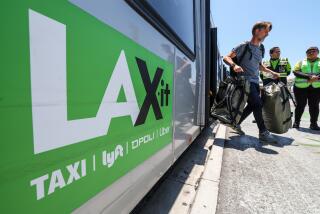Taxi apps take guesswork out of getting a ride
Like many Southern California residents, I resisted ever hailing a taxi.
The region’s traffic and sprawl hinted at exorbitant fares. Figuring out whom to call and then waiting on hold to order a cab added to my reluctance.
But now with a smartphone, I’ve found ordering a taxi has actually become inviting. Anxious waits have been eliminated because you can track a taxi’s journey to you on a digital map. Estimating fares, paying them, leaving tips and getting receipts can all be completed through an app.
People who avoid taxis because they consider them scary or their drivers frustrating also have easy smartphone options. Apps such as Lyft, Sidecar and Uber connect people to drivers willing to give rides at fares sometimes equivalent to or cheaper than taxis.
Here’s a look at some taxi and ride-sharing apps.
Flywheel, a San Francisco start-up, partnered with Bell Cab Co., the highest-rated taxi fleet of the nine in the city of Los Angeles. Bell’s 320 green-colored taxis also roam Santa Monica, Manhattan Beach, Hermosa Beach, Torrance, Redondo Beach, Lawndale, Hawthorne, El Segundo, Palos Verdes, Lomita and Rolling Hills.
Once you download the free Flywheel app for Apple or Android, you enter contact and credit card details to create an account.
Turning on Wi-Fi or GPS lets the app determine your location. You can then move a pointer to your exact pickup location or select it from a drop-down list of major venues, such as businesses, shops and hotels. Then you’ll see icons hovering over locations of nearby Bell taxis.
If you’re satisfied there’s one close enough, you tap “Request Taxi.” The closest driver gets first dibs to accept the request. Then you can track the taxi and its expected time until arrival on a map in the app.
The app notifies you when the taxi’s arrived and the driver can call you if needed. Drivers have been instructed to ask for your name, but neither of the two drivers I met did so. One of the drivers also forgot to turn on the fare meter at the beginning of my ride as he fumbled around with an instruction packet about how to use Flywheel.
The drivers have their own app on a smartphone that Flywheel placed in every cab. Drivers plug the final fare into their app, you set a tip on your app and Flywheel tacks on a $1 service fee. The grand total is automatically charged to your credit card. A receipt is emailed. Any incorrect charges can be disputed with Flywheel.
During a trip to Silver Lake from downtown on a Wednesday morning, I waited about 10 minutes for a Bell Cab when the app originally listed the estimated time of arrival as eight minutes. The wait for the return cab was a spot-on five minutes.
Unfortunately, Flywheel doesn’t yet offer estimates for the fare or trip time. Another missing feature is a transaction history that gathers receipts in the apps. But Flywheel says all of that is coming soon.
Flywheel lets you rate drivers. I gave them both “5 stars,” though the first vehicle had an annoying cigarette stench. In the name of fairness, drivers get to rate you too. They both gave me “5 stars,” Flywheel said.
About 50 people a day are using Flywheel since it was launched two weeks ago. Bell Cab Co. general manager Michael Kalin expects the number to hit more than 500 by winter.
“We think mostly this is new business, so we like the results we are seeing so far,” Kalin said, noting that Flywheel gives traditional taxis a chance to combat other apps that have them worried.
Uber
High on that competitor list is Uber, an app that works the same way as Flywheel. But Uber advertises two benefits: friendly service and clean cars. At higher costs, an Uber driver will pick you up in a fancy SUV or luxury sedan. Otherwise, the cheaper version known as UberX involves a Toyota Prius.
Uber’s app does have a fare calculator, so you know how much a ride might cost. Longer rides on UberX might be cheaper than traditional taxis. A trip of a few miles probably should cost about the same as a taxi.
Uber is also available through an official app for BlackBerry and an unofficial app for Windows Phone.
Lyft and Sidecar
Fellow San Francisco start-ups Lyft and Sidecar have apps that let people give rides in their own cars. Lyft, which promises a “fun” and “social” ride, is more recognizable because of the pink mustache found on the front grill of drivers’ cars. Sidecar is popular among commuters.
Riders request a driver in the same way as with the other taxi apps, and you can see how close the nearest driver is before you book. While there’s no fare calculator in either app, Sidecar will at least show you a fare estimate before booking.
Payment — again done through the app — is technically a voluntary donation because the services want to avoid falling under the same regulations as taxis.
Uber, Lyft and Sidecar do background checks of drivers and inspect vehicles. The California Public Utilities Commission is looking at creating formal rules for “e-hail” apps.
Twitter: @peard33
More to Read
Inside the business of entertainment
The Wide Shot brings you news, analysis and insights on everything from streaming wars to production — and what it all means for the future.
You may occasionally receive promotional content from the Los Angeles Times.











